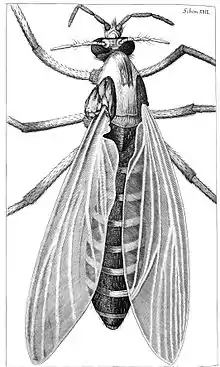Gnat
A gnat /ˈnæt/ is any of many species of tiny flying insects in the dipterid suborder Nematocera, especially those in the families Mycetophilidae, Anisopodidae and Sciaridae.[1] They can be both biting and non-biting. Most often they fly in large numbers, called clouds. "Gnat" is a loose descriptive category rather than a phylogenetic or other technical term, so there is no scientific consensus on what constitutes a gnat.


Some entomologists consider only non-biting flies to be gnats.[1] Certain universities also distinguish eye gnats: the Smithsonian Institution describes them as "non-biting flies, no bigger than a few grains of salt, ... attracted to fluids secreted by your eyes".[2]
Description
Male gnats often assemble in large mating swarms, or ghosts, particularly at dusk.
Gnat larvae are mostly free-living, and some are aquatic. Many feed on plants, though some are carnivorous. Larval plant feeders (such as the Hessian fly larva) cause root, stem, or leaf galls to be formed by the host plant. Some species of fungus gnats (families Mycetophilidae and Sciaridae) are pests of mushrooms and roots of potted plants in homes and greenhouses.
Black fly and biting midges, also belonging to the gnat category, are small, sometimes barely visible, blood-sucking flies commonly known in many areas as biting gnats, sand flies, punkies or "no-see-ums".
Some South American pleurothallid orchids are pollinated by tiny gnats and have correspondingly small flowers.
Life cycle
Non-biting gnat populations abide near water, including wet soils; and are usually active in the summer. However, they can occur during any time of year in moist coastal regions. [3] Male gnats swarm at dusk. The mating occurs as soon as the females enter the swarm. [4] The females lay eggs en masse over water or attached to aquatic vegetation. The hatching continues over several days with the young larvae dropping to the bottom and building tubelike structures of debris. [4] Larvae are small worm-like creatures that feed on organic material. The larvae stage continues for about a month after which the species pupate for a few days. Before emerging, the pupa rises to the surface of the water, serving as a nutritious food for fish. [4] The pupal stage culminates in the metamorphosis of larvae into winged adults, which usually last less than seven days. Adults live for about another week and a half during which they produce up to 300 eggs. One female gnat can lay up to 1,000 eggs during its lifetime. [5]
Control
Adult non-biting gnats do not damage plants and are considered a nuisance. Usually, larvae do not cause serious plant damage, but when present in large numbers can stunt the plant growth and damage its roots.[3] To prevent gnats from spreading, measures have to be taken to target immature stages of development of the species. Physical tactics include eliminating favorable living conditions: reduction of excess moisture, drainage of pools with standing water, and removal of decaying organic matter. [6] Commercially available control agents and insecticides can be used as a control measure, but are not recommended for use in a household. [3] To control adult gnats in smaller areas, pressurized aerosol sprays with pyrethrins can be used. [1] Other control measures in the household can include turning off unnecessary lights at dusk and sealing vents and other openings. [4]
See also
- Black fly
- Enicocephalidae (gnat bugs)
- Cecidomyiidae (gall gnats)
- Sciaridae (dark-winged fungus gnats)
- Ceratopogonidae
- Midge
- Mosquito
- Sandfly
References
| Wikisource has the text of the 1911 Encyclopædia Britannica article Gnat. |
- "Midges and Gnats | Entomology". entomology.ca.uky.edu. Retrieved 2016-09-22.
- Gibbons, John. "Gnats Always Keep an Eye Out for a Good Place to Eat". Smithsonian Institution. Retrieved 2018-01-21.
- "Fungus Gnats". ipm.ucanr.edu. Retrieved 2018-10-26.
- "Midges: Non-biting Gnats". lancaster.unl.edu. Retrieved 2018-10-26.
- "Fungus Gnats". pss.uvm.edu. Retrieved 2018-10-26.
- "How to Get Rid Of Gnats". stoppestinfo.com. Retrieved 2018-10-26.